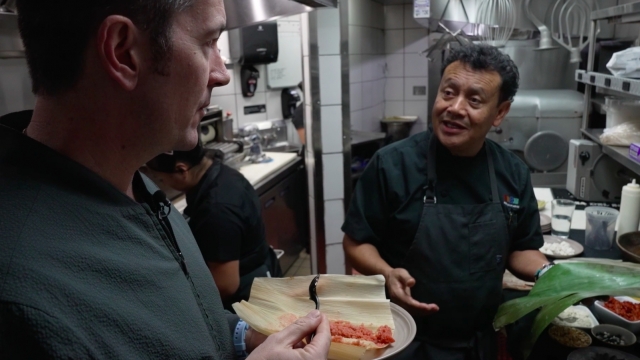As turkey is to Thanksgiving, tamales are to Christmas in Texas. Amidst poinsettia, mistletoe, holiday parties and trendy yuletide cocktails, the Mexican staple — with a culinary history spanning centuries — is a constant in the Southwest United States.
Christmas time at Hugo's Restaurant in Houston is hustle and bustle with the seasonal crowd. It's made even busier as they handcraft tradition in a corn husk.
Hugo Ortega, owner and award-winning chef at his eponymous restaurant amongst several others in the nation's fourth largest city says he'll sell thousands of the dense delights by New Year's Day. That means if you want dibs on his gourmet tamales — or tamales at any respected Mexican restaurant — you need to order ahead.
"It can be overwhelming at times," Ortega said, adding that his staff often works long hours filling tamales and other orders.
"Our culture is to give. So we say, you want to order a tamal, we can give you a tamal. But we sell by the dozen. Some people want 6 dozen, some want 10 dozen," Ortega added while showing off some of his culinary interpretations in the kitchen.
The structure and method is simple: a protein or vegetable filling, surrounded by ground corn turned into a dough, depending on the region. You cook the contents by steaming in either a corn husk or a banana leaf.
"In the Yucatan, they have tamales de pescado," Ortega said while offering the news crew a sample drizzled with a golden mole sauce.
Tamales have an indigenous Mesoamerican origin. In many of the Mexican cultures the delicacy had Native religious significance. The basic recipe has survived for centuries: It's a portable nutrient-dense dish often containing an animal fat as a binding agent for the masa dough — and it comes in a biodegradable wrapper.
Above all, Ortega says it's not only reminiscent of the holiday season, but also of heritage.
For many Mexican Americans, the seasonal staple evokes memories of Christmas.
"They take on special meaning," said Texas Monthly Magazine Taco Editor José Ralat. "They're very hard to make," he said.
SEE MORE: TSA releases guidance after bullets were found concealed in diaper
Ralat said that's because the tamale process is a step-by-step, sometimes painstaking series of tasks steamed in tradition, which often requires accomplishing in a family group to divide the labor.
"This is important because if you're taking the time to make the tamales fresh, you're showing your love. Not only for the people, but for the culture," Ralat said.
While simple in construction, tamale creation at home can be complicated. You have to get the ingredients, make the masa dough, make a filling, prepare your wrappers, roll them up and steam them. It often requires an assembly line, sometimes with family members.
"I believe that some of the complex recipes of Mexican cooking or really any kind of cuisine end up being food that we serve for special occasions," said chef Sylvia Casares. "Because it's not like you're going to decide you're going to make them for dinner tonight."
Casares, an award-winning chef, owns Sylvia's Enchilada Kitchen. And while amongst her faithful customers, she earned the moniker "The Enchilada Queen," her restaurants also make tamales by the thousands. She trains novices in the art of tamale making.
"It's like a taco — if you put too much filling it doesn't work," Casares said while showing us how to make a tamale.
For these famous Houston chefs, tamales are a labor of love, but help make lifetime memories and preserve culture.
Trending stories at Scrippsnews.com



